Repair Performance of Self-Healing Microcapsule/Epoxy Resin Insulating Composite to Physical Damage
Abstract
:1. Introduction
2. Materials and Methods
2.1. Materials and Preparation
2.1.1. Preparation of Microcapsule
2.1.2. Preparation of Self-Healing Epoxy Resin Insulating Composite
2.2. Methods
2.2.1. Mechanical Damage Test
2.2.2. Electrical Damage Test
3. Results and Discussion
3.1. Repair Performance of Mechanical Damage
3.1.1. Structural Change of Scratch
3.1.2. Structural Change of Cross-Section
3.1.3. Change of Insulation Strength to Scratch Damage
3.2. Repair Performance of Electrical Damage
4. Conclusions
- (1)
- For the mechanical damage, the microcapsule/epoxy resin composite exhibit excellent self-healing ability. The repair efficiency of scratch width is 70%~100%, and the repair rate is relatively fast. Moreover, the core material of the microcapsule has great fluidity and reactivity. In addition, the repair process is mainly affected by the action of the capillary and molecular diffusion model on the defect surface.
- (2)
- For the electrical damage, the repair effect of composite to the electrical tree is obvious. The microcapsule can not only attract the electrical tree and inhibit its propagation, but also repair the tubules of electrical tree effectively. It has good application value in reducing the harm of electrical damage to insulating material.
- (3)
- Physical damage can reduce the insulation strength of material, thus threatening the stability of the power system. The composite can not only fill the structural defect caused by electrical damage (such as an electrical tree) and mechanical damage (such as a scratch), but also homogenize the local high electric field in the defect area, restoring its insulation strength. The restoration effect of electrical insulation performance is mainly affected by the reaction effect of repairing agent and the interface characteristic between the repair product and the matrix material.
Author Contributions
Funding
Conflicts of Interest
References
- Liu, C.; Zheng, X.; Bie, C. Research of Preparation and Non-Linear Conductivity Modification of Doped ZnO/Epoxide Resin Material. Trans. Chin. Electrotech. Soc. 2016, 31, 24–30. [Google Scholar]
- Zhang, X.; Wu, Y.; Wen, H.; Chen, X.; Xiao, S. Study on Microcapsules for Self-healing System of Insulating Epoxy Resins. Proc. CSEE 2018, 38, 2808–2814. [Google Scholar]
- Wang, Y.; Liu, H.; Li, W.; Ding, R. An Investigation of Surface Tracking Characteristics and Factors Influencing Epoxy Resin Pouring Insulation for Dry-type Reactors. Macromol. Res. 2018, 27, 310–320. [Google Scholar] [CrossRef]
- Liang, M.; Wong, K. Improving the long-term performance of composite insulators use nanocomposite: A review. Energy Procedia 2017, 110, 168–173. [Google Scholar] [CrossRef]
- Wang, Y.; Liu, Y.; Wang, S.; Xu, H. The Effect of Electrothermal Aging on the Properties of Epoxy Resin in Dry-Type Transformer. Trans. Chin. Electrotech. Soc. 2018, 33, 250–260. [Google Scholar]
- Arronche, L.; Saponara, V.; Yesil, S. Impact damage sensing of multiscale composites through epoxy matrix containing carbon nanotubes. J. Appl. Polym. Sci. 2013, 128, 2797–2806. [Google Scholar] [CrossRef]
- Saurín, N.; Sanes, J.; Bermúdez, M. Self-Healing of Abrasion Damage in Epoxy Resin–Ionic Liquid Nanocomposites. Tribol. Lett. 2015, 58, 4. [Google Scholar] [CrossRef]
- Hu, P.; Li, C.; Chen, D. Cause Analysis and Countermeasure Study of Cracking Accident of Cable GIS Terminal Epoxy Casing. Electr. Power Eng. Technol. 2017, 36, 102–105. [Google Scholar]
- Wang, Y.; Liu, Y.; Xiao, K. The effect of hygrothermal aging on the properties of epoxy resin. J. Electr. Eng. Technol. 2018, 13, 892–901. [Google Scholar]
- Chen, L.; Tsao, T.; Lin, Y. New diagnosis approach to epoxy resin transformer partial discharge using acoustic technology. IEEE Trans. Power Deliv. 2005, 20, 2501–2508. [Google Scholar] [CrossRef]
- Huang, M.; Zhou, K.; Yang, D.; Yang, M. Effect of On-Line Rejuvenation on Water Tree Propagation in XLPE Cables. Trans. Chin. Electrotech. Soc. 2016, 31, 176–182. [Google Scholar]
- Brown, E.N.; White, S.R.; Sottos, N.R. Retardation and repair of fatigue cracks in a microcapsule toughened epoxy composite—Part II: In situ self-healing. Compos. Sci. Technol. 2005, 65, 2474–2480. [Google Scholar] [CrossRef]
- Yang, M.; Zhou, K.; Wu, K.; Tao, W.; Yang, D. A New Rejuvenation Technology Based on Formation of Nano-SiO2 Composite Fillers for Water Tree Aged XLPE Cables. Trans. Chin. Electrotech. Soc. 2015, 30, 481–487. [Google Scholar]
- Wei, G.; Tang, J.; Zhang, X.; Lin, J. Gray intensity image feature extraction of partial discharge in high-voltage cross-linked polyethylene power cable joint. Int. Trans. Electr. Energy Syst. 2014, 24, 215–226. [Google Scholar] [CrossRef]
- Xu, T.; Dong, X.; Li, R.; Liu, G.; Xia, H.; Xia, Z. Ultrasonic Phased Array Detection of Composite Insulator Internal Defects. Electr. Power Eng. Technol. 2018, 37, 75–79. [Google Scholar]
- White, S.R.; Sottos, N.R.; Geubelle, P.H.; Moore, J.S.; Kessler, M.R.; Sriram, S.R. Autonomic healing of polymer composites. Nature 2001, 409, 794–797. [Google Scholar] [CrossRef] [PubMed]
- Bekas, D.G.; Tsirka, K.; Baltzis, D.; Paipetis, A.S. Self-healing materials: A review of advances in materials, evaluation, characterization and monitoring techniques. Compos. Part. B Eng. 2016, 87, 92–119. [Google Scholar] [CrossRef]
- Kang, J.; Tok, J.B.-H.; Bao, Z. Self-Healing Soft Electronics. Nat. Electron. 2019, 2, 144–150. [Google Scholar] [CrossRef]
- Li, W.; Dong, B.; Yang, Z.; Xu, J.; Chen, Q.; Li, H.; Xing, F.; Jiang, Z. Recent Advances in Intrinsic Self-Healing Cementitious Materials. Adv. Mater. 2018, 30, 1705679. [Google Scholar] [CrossRef]
- Murphy, E.B.; Wudl, F. The world of smart healable materials. Prog. Polym. Sci. 2010, 35, 223–251. [Google Scholar] [CrossRef]
- An, S.; Lee, M.W.; Yarin, A.L.; Yoon, S.S. A Review on Corrosion-Protective Extrinsic Self-Healing: Comparison of Microcapsule-Based Systems and Those Based on Core-Shell Vascular Networks. Chem. Eng. J. 2018, 344, 206–220. [Google Scholar] [CrossRef]
- Zhang, X.; Ji, H.; Qiao, Z. Residual stress in self-healing microcapsule-loaded epoxy. Mater. Lett. 2014, 137, 9–12. [Google Scholar] [CrossRef]
- Lesaint, C.; Risinggard, V.; Hølto, J.; Saeternes, H.H.; Hestad, Ø.; Hvidsten, S. Self-healing high voltage electrical insulation materials. In 2014 IEEE Electrical Insulation Conference (EIC); IEEE: Piscataway, NJ, USA, 2014; pp. 241–244. [Google Scholar]
- Yang, Y.; He, J.; Li, Q.; Gao, L.; Hu, J.; Zeng, R.; Qin, J.; Wang, S.; Wang, Q. Self-healing of electrical damage in polymers using superparamagnetic nanoparticles. Nat. Nanotechnol. 2019, 14, 151. [Google Scholar] [CrossRef] [PubMed]
- Wang, Y.; Li, Y.; Zhang, Z.; Zhang, Y. Effect of Doping Microcapsules on Typical Electrical Performances of Self-Healing Polyethylene Insulating Composite. Appl. Sci. 2019, 9, 3039. [Google Scholar] [CrossRef]
- Schaubroeck, D.; Brughmans, S.; Vercaemst, C.; Scheaubroeck, J.; Verpoort, F. Qualitative FT-Raman investigation of the ring opening metathesis polymerization of dicyclopentadiene. J. Mol. Catal. A Chem. 2006, 254, 180–185. [Google Scholar] [CrossRef]
- Álvaro, G. Self-healing of open cracks in asphalt mastic. Fuel 2011, 93, 264–272. [Google Scholar]
- Wang, Y.; Wang, S.; Lu, G.; Huang, Y.; Yi, L. Influence of Nano-Al N Modification on the Insulation Properties of Epoxy Resin of Dry-Type. Trans. Chin. Electrotech. Soc. 2017, 32, 174–180. [Google Scholar]
- Wu, Z.; Wang, C.; Zhang, M.; Pei, X.; Jiang, P. Interface of Epoxy Resin Composites, and Its Influence on Electrical Performance. Trans. Chin. Electrotech. Soc. 2018, 33, 241–249. [Google Scholar]
- Chen, Y.; Meng, G.; Dong, C. Review on the Breakdown Characteristics and Discharge Behaviors at the Micro & Nano Scale. Trans. Chin. Electrotech. Soc. 2017, 32, 13–23. [Google Scholar]
- Rohde, B.J.; Le, K.M.; Krishnamoorti, R.; Robertson, M.L. Thermoset Blends of an Epoxy Resin and Polydicyclopentadiene. Macromolecules 2016, 49, 8960–8970. [Google Scholar] [CrossRef]
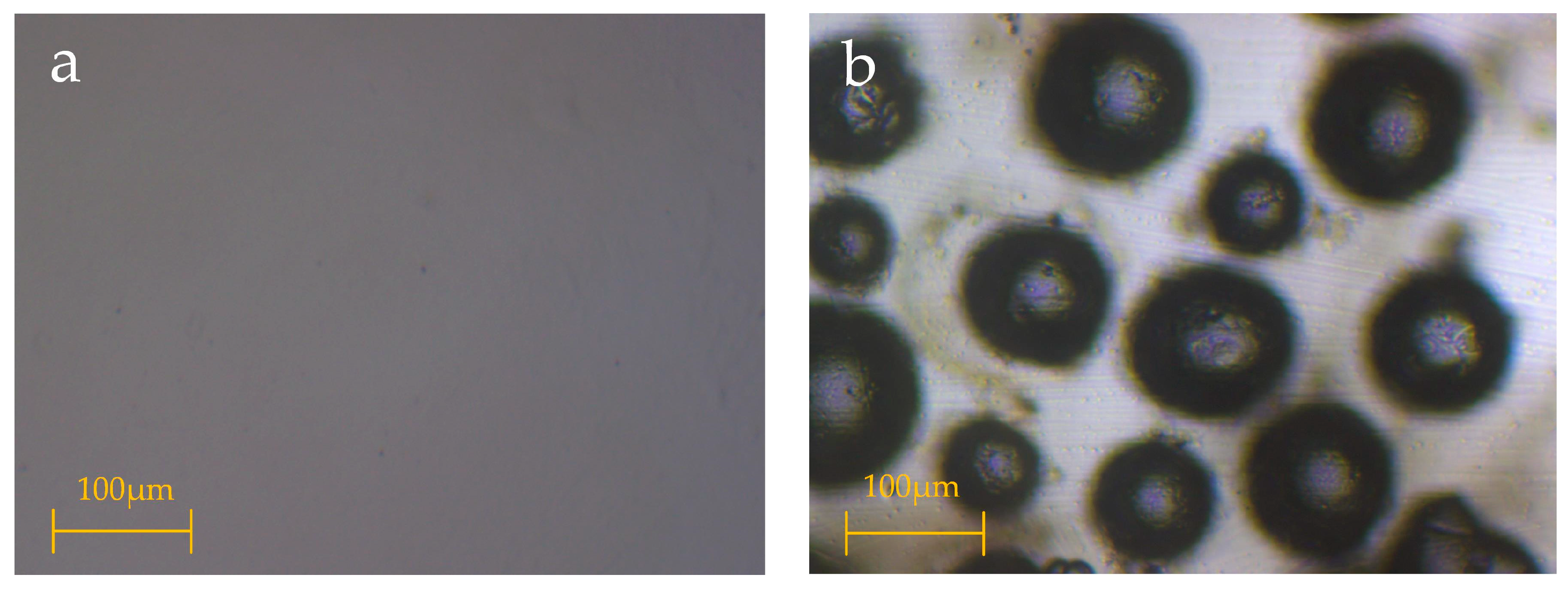

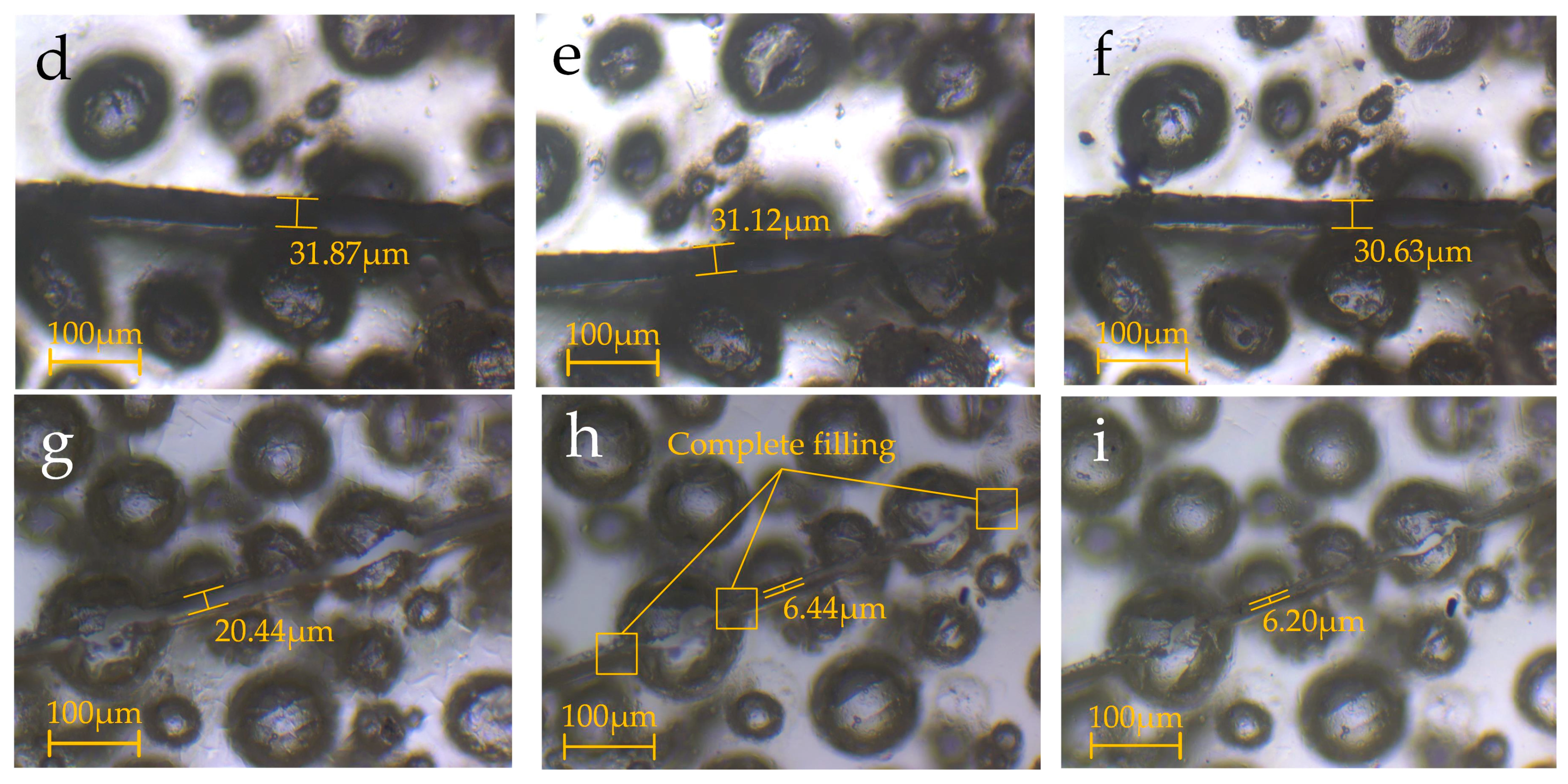
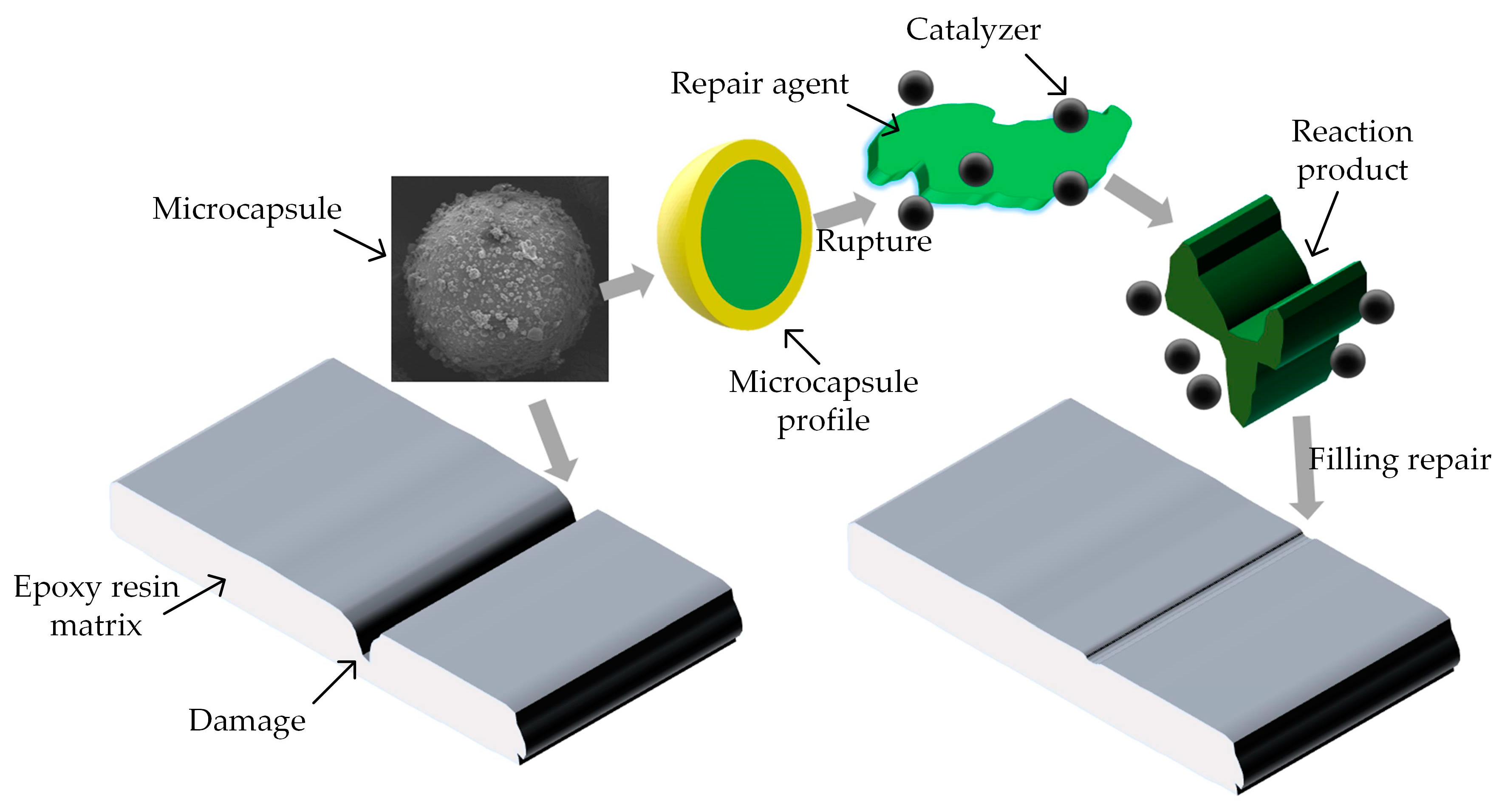


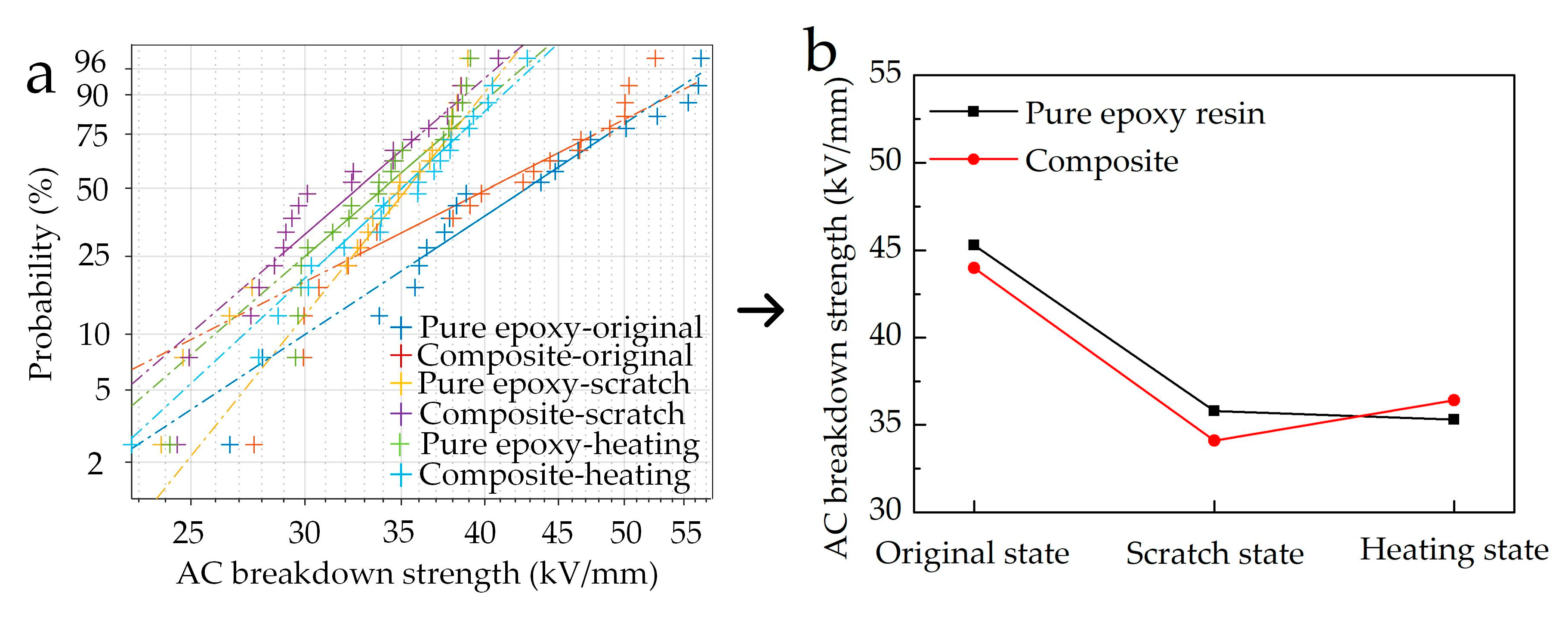
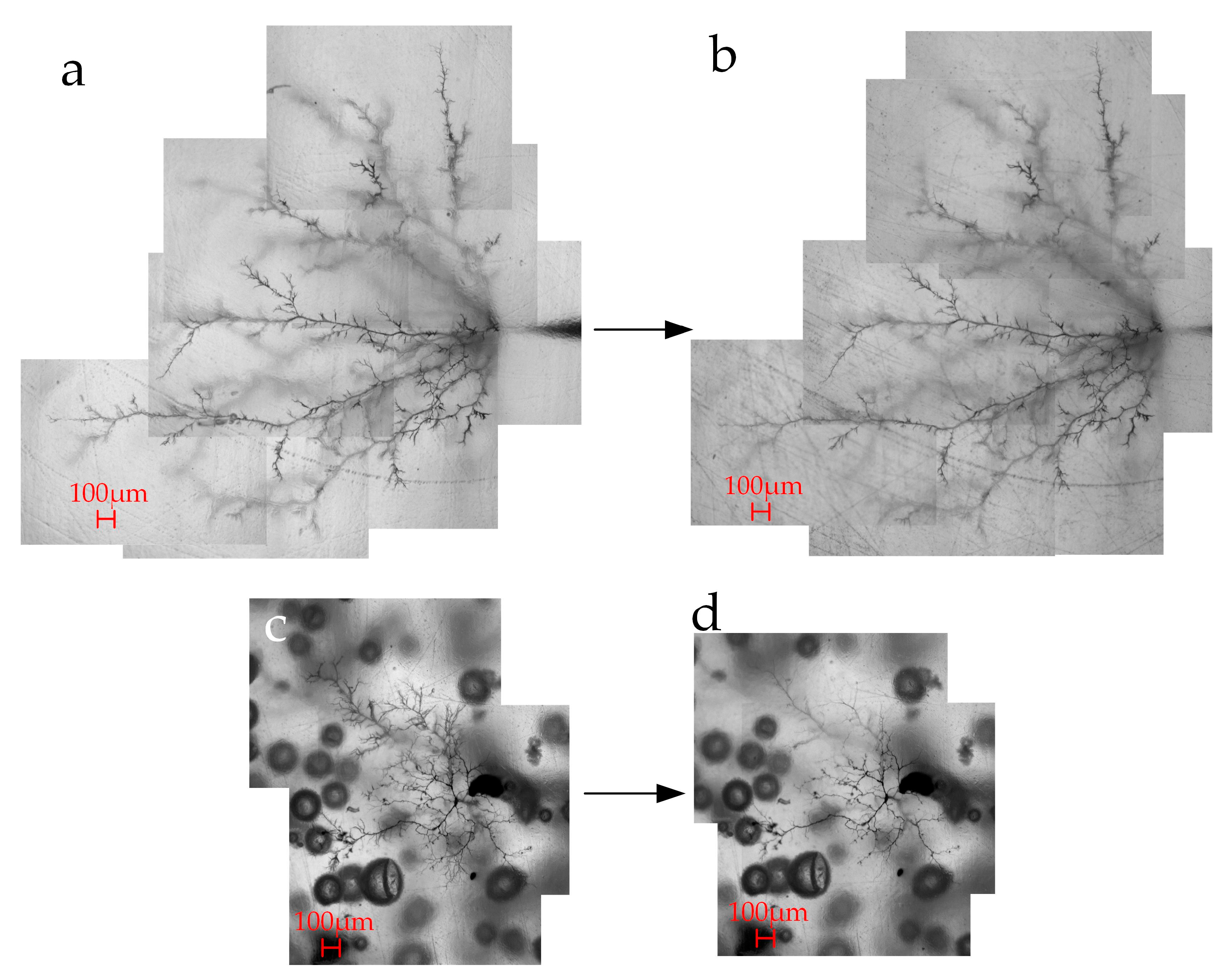
| Basic Performances of Composite | Concentrations of Microcapsule in Composite | ||||
|---|---|---|---|---|---|
| 0 wt. % | 0.5 wt. % | 1 wt. % | 5 wt. % | 10 wt. % | |
| Repair efficiency to scratch about 25 μm wide (%) | 0 | ≥50 | ≥70 | ≥73 | ≥76 |
| Thermal decomposition temperature (℃) | 396.8 ± 1.5 | 399.1 ± 1.9 | 402.7 ± 2.3 | 400.3 ± 2.1 | 391.0 ± 3.9 |
| Young’s modulus (GPa) | 2.67 ± 0.03 | 2.63 ± 0.13 | 2.50 ± 0.21 | 2.34 ± 0.17 | 2.11 ± 0.33 |
| Tensile strength (MPa) | 51.6 ± 2.7 | 50.0 ± 1.9 | 46.1 ± 3.1 | 40.3 ± 2.9 | 32.6 ± 3.7 |
© 2019 by the authors. Licensee MDPI, Basel, Switzerland. This article is an open access article distributed under the terms and conditions of the Creative Commons Attribution (CC BY) license (http://creativecommons.org/licenses/by/4.0/).
Share and Cite
Wang, Y.; Li, Y.; Zhang, Z.; Zhao, H.; Zhang, Y. Repair Performance of Self-Healing Microcapsule/Epoxy Resin Insulating Composite to Physical Damage. Appl. Sci. 2019, 9, 4098. https://doi.org/10.3390/app9194098
Wang Y, Li Y, Zhang Z, Zhao H, Zhang Y. Repair Performance of Self-Healing Microcapsule/Epoxy Resin Insulating Composite to Physical Damage. Applied Sciences. 2019; 9(19):4098. https://doi.org/10.3390/app9194098
Chicago/Turabian StyleWang, Youyuan, Yudong Li, Zhanxi Zhang, Haisen Zhao, and Yanfang Zhang. 2019. "Repair Performance of Self-Healing Microcapsule/Epoxy Resin Insulating Composite to Physical Damage" Applied Sciences 9, no. 19: 4098. https://doi.org/10.3390/app9194098
APA StyleWang, Y., Li, Y., Zhang, Z., Zhao, H., & Zhang, Y. (2019). Repair Performance of Self-Healing Microcapsule/Epoxy Resin Insulating Composite to Physical Damage. Applied Sciences, 9(19), 4098. https://doi.org/10.3390/app9194098




